On paper, renting an apartment seems straightforward enough. You view a property within your budget that you like, you sign the tenancy agreement, and you move in.
Simple, right? Well, not quite. There are many horror stories from tenants who were forcibly evicted by nightmare landlords, and it seems a new case surfaces every couple of months.
HDB rental policy loophole
In this scenario, a tenant signed a three-year tenancy agreement on a 5-room flat for S$2,600 a month. With just eight months left on the lease, the landlord (who was also the property agent representing the unit) went nuclear and forcibly evicted the tenant by acquiring a HDB letter terminating approval to rent out the entire unit citing that she wanted to move back into the flat.
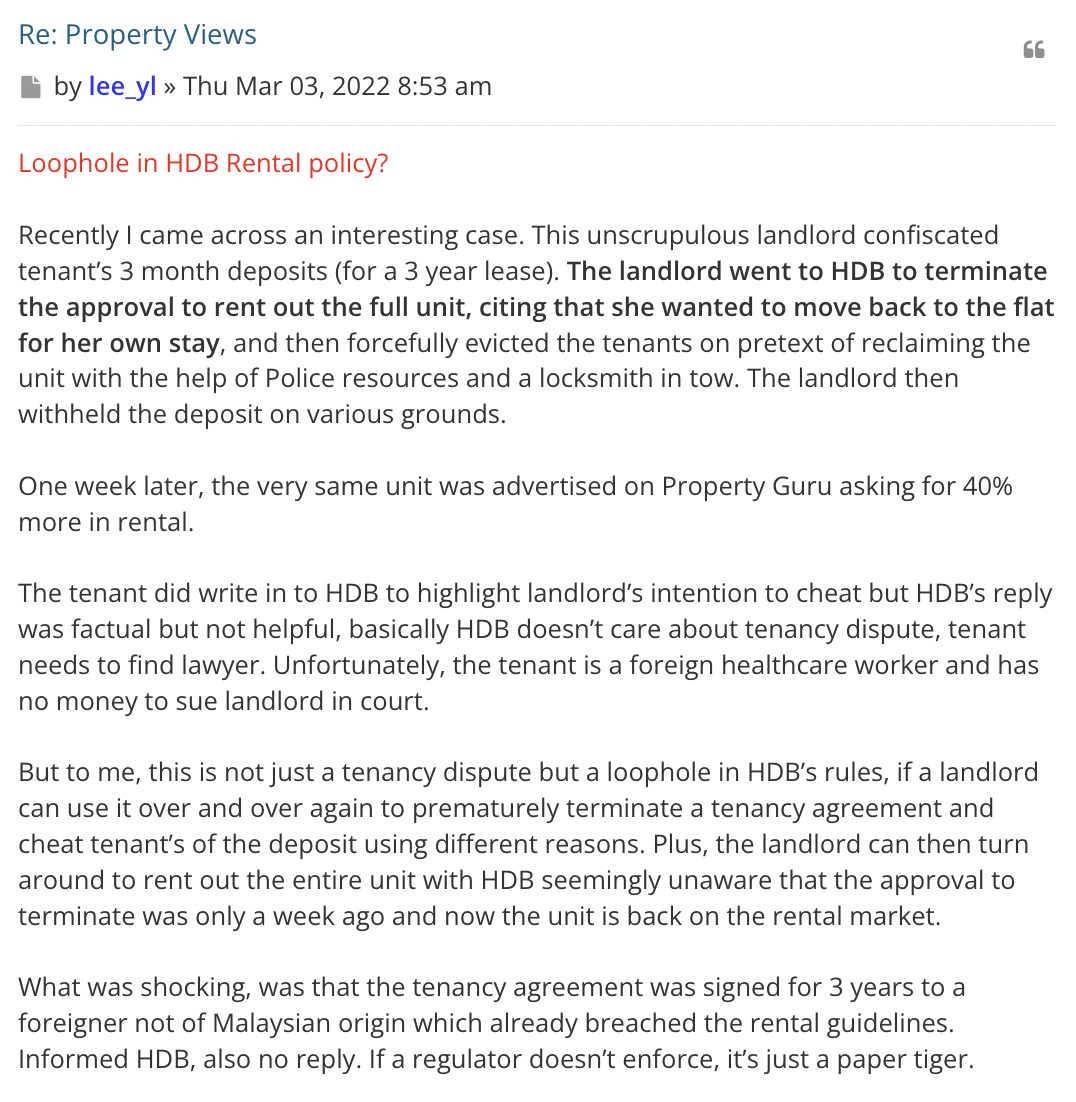 She successfully evicted them with the letter in hand as well as the police and locksmith in tow. A week later, the same unit went up again for rent, with an asking price of S$4,000 per month – a 53% increase from the original asking price.
She successfully evicted them with the letter in hand as well as the police and locksmith in tow. A week later, the same unit went up again for rent, with an asking price of S$4,000 per month – a 53% increase from the original asking price.
That’s not the worst part. The landlord refused to return her tenant’s three-month deposit of S$7,800, claiming the kitchen tiles were chipped and needed to be hacked and re-tiled.
However, it was only two weeks between receiving HDB’s termination letter and having the unit posted up for rent again. This means the landlord never had the intention to renovate or stay in the unit at all.
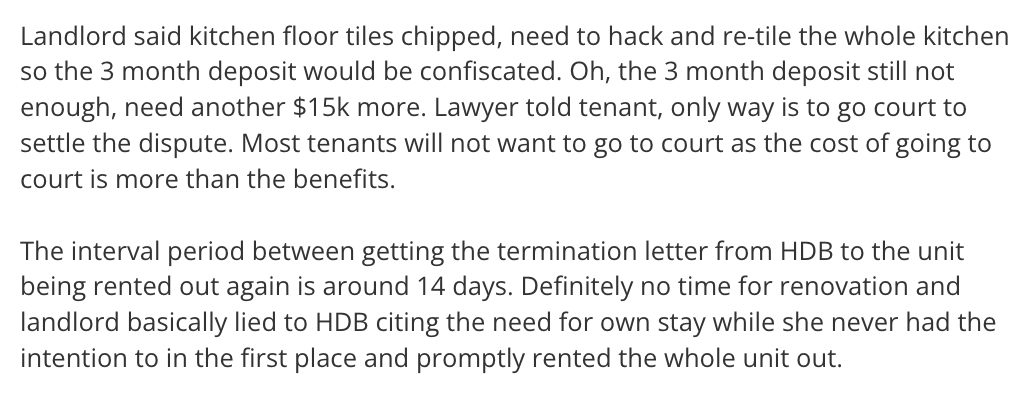
Despite efforts to seek help from HDB, they allegedly told the tenant to seek out a lawyer’s help. The lawyer said that the only way to settle the dispute was to take it to court, which most tenants would baulk at the cost of a court case would be way more than getting the deposit back.
Breach of rules from the get-go
Here’s the kicker. The tenant is neither a Malaysian nor Singaporean but a foreign healthcare worker.
For the uninitiated, the maximum period of occupancy for a HDB flat or room is a maximum period of three years if all tenants are Singaporeans or Malaysians. For everyone else, the maximum rental period is two years.
The landlord had already breached the tenancy rules before the tenancy even commenced.
According to the tenant, the previous group of tenants were foreign students who experienced the same treatment. Their tenancy was terminated halfway through the tenancy, with their belongings dumped unceremoniously along the corridor.

Since the tenancy agreement was longer than two years, the tenant couldn’t bring the case to Small Claims Tribunal.
The tenant then brought the matter to a lawyer, who told them it would take between S$5,000 to S$8,000 to fight the case. Even if the court ruled in the tenant’s favour, the landlord could still drag her feet to pay back the deposit.

Threats to cause workplace disruptions
With the tenants being foreigners, they may have been unfamiliar with the rental process or trusted the landlord too much while signing the tenancy agreement. This might have resulted in them unwittingly signing themselves into an unfair contract that allowed the landlord to evict them at the landlord’s whim.
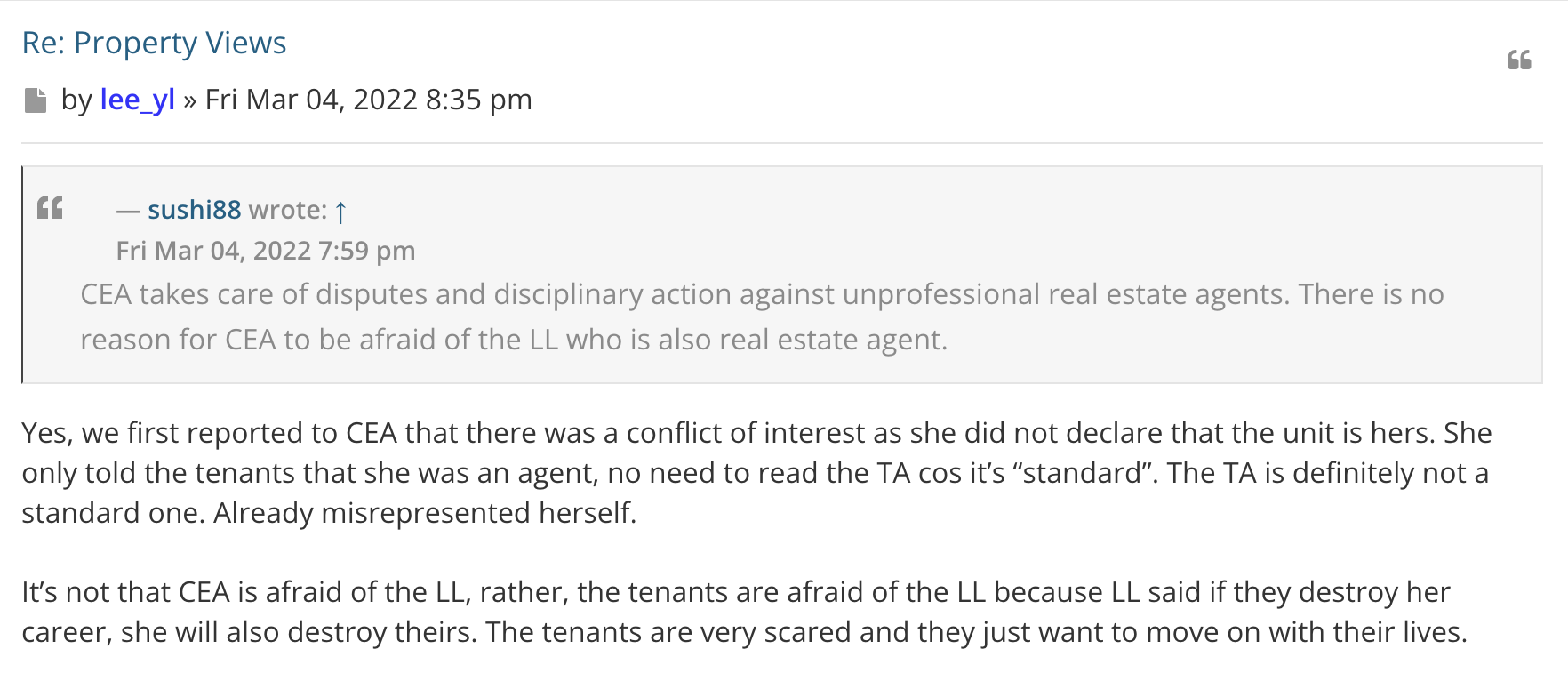
The landlord even threatened to go to the tenant’s workplace to cause a scene, which she had done before and caused the tenant to receive a warning letter from the HR department.
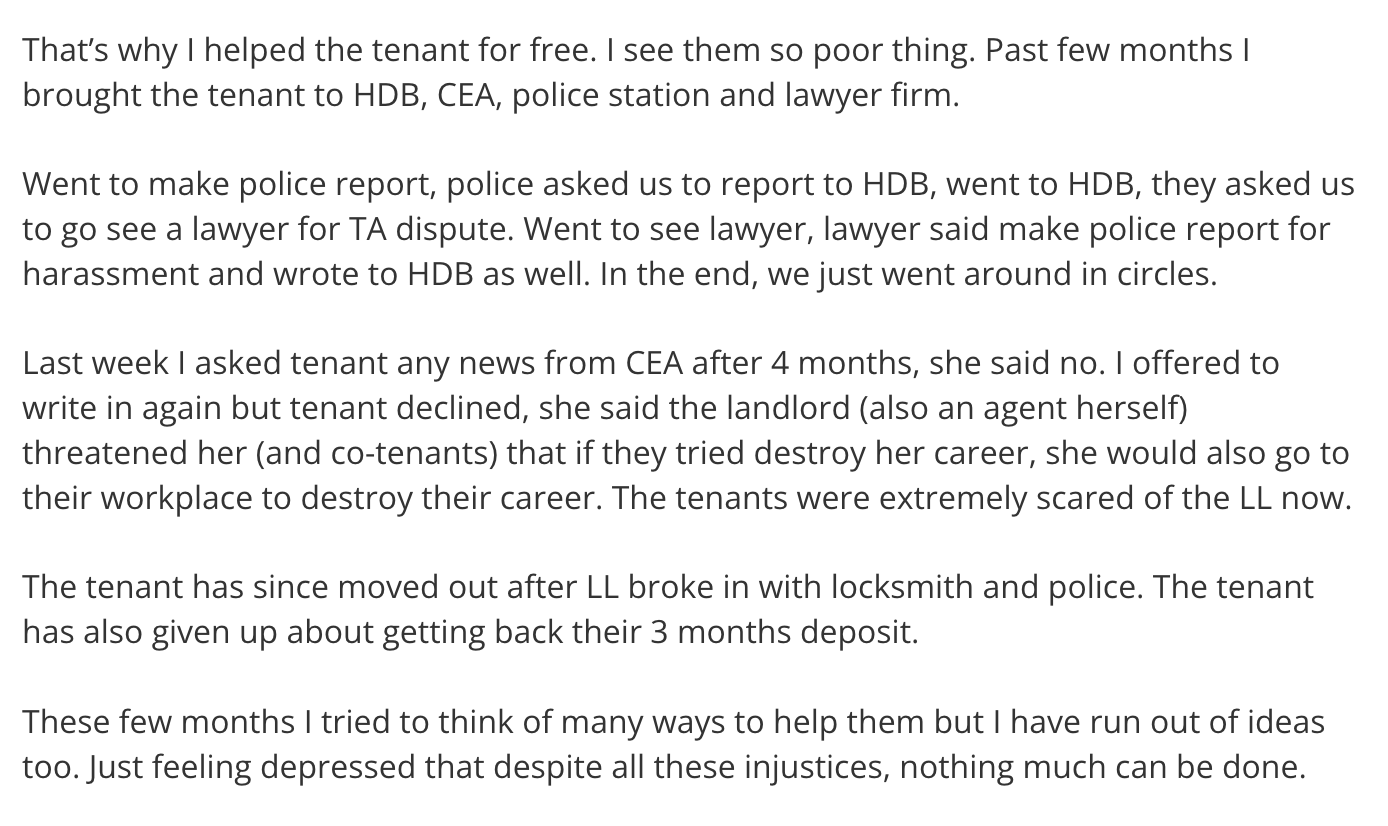

After going around in circles with the relevant authorities, the tenant seems to have given up hope of recouping her deposit. The cost of taking legal action would be not just financially but also emotionally taxing on the tenant.
To avoid getting into hot soup as a tenant, here are five things you should take note of before signing your tenancy agreement.
1. Check the Non-Citizen quota
To prevent foreigner enclaves from taking root in HDB estates, the government implemented a Non-Citizen (NC) quota for landlords intending to rent out their flats.
The quota applies as long as one of the tenants is a non-Malaysian non-citizen, including Singapore permanent residents and foreigners. Due to Malaysia sharing close cultural and historical similarities with Singaporeans, they’re not subject to the quota.
Non-Malaysian NC quota at neighbourhood level: 8%
Non-Malaysian NC quota at block level: 11%
Once the quota has been reached, only Singaporeans or Malaysians can rent a unit in the neighbourhood or block.
Checking the NC quota of a flat can be done so here.
2. Always read the tenancy agreement
No matter how much an agent tells you that the tenancy agreement is “standard”, make sure you read and understand every single page of it.
Any vagueness in the agreement should be discussed and addressed in case things turn sour with the landlord.

If you’re a foreigner, make sure there’s a diplomatic clause written into it. You might be required to leave the country on short notice, and the clause allows you to terminate the lease before it’s up without suffering any penalties.
Without a diplomatic clause, you might have to keep paying the monthly rent even if you’re not living there anymore.
Don’t be pressured into signing something you haven’t read and if you see something in the agreement that you’re unsure about, clarify it with the agent. You will regret it when an unpleasant situation arises during your rental journey.
3. Right of re-entry
A landlord can only forfeit the tenancy and enter the premises if the tenant breaches the terms of the agreement, such as failing to pay rent.
Re-entry can only be done if the landlord makes a formal demand and legal proceedings to take back possession of the unit are carried out.
However, this is a harsh option, and the courts will usually give the tenant up to a month to make amends and pay rent so the tenancy can continue.
Most leases will also have a clause written to give tenants “exclusive possession” of the unit. This means that the landlord will not be able to barge in unannounced anytime they wish to do a surprise check or let others view it.
To avoid waking up to strangers in your house, we reiterate: Read the tenancy agreement thoroughly.
4. You are not liable for damages exceeding a certain amount
When my partner and I rented our first apartment, we were so caught up in the excitement of having our own place that we glanced through the tenancy agreement briefly and inked the deal within minutes.
It was a relatively new apartment where the landlord had mounted a television right beside the balcony. Because of the afternoon sun, there was strong sunlight shining directly on the TV.
After two years, the screen had warping on the edges, which we overlooked because we barely used it over the rental period of two years. When the lease was up, the landlord demanded we replace the TV, saying we were careless with her possessions.
Being a non-confrontational person, I was ready to agree to it and pay for the full cost of a brand new TV, which was about S$2,500. However, my partner stepped in and negotiated down to a partial payment of around S$600 instead.
While it’s not clear who was at fault here, we reached an amicable solution and got back most of our deposit.
However, do note that the tenant covered damage caused by wear and tear in most tenancy agreements. The amount ranges depending on the agreement, but it usually does not exceed S$200.
For example, if the washing machine breaks down and costs S$300 to fix, you’ll have to pay S$200, and the landlord will cover the remaining S$100.
Ensure there’s also a 30-day live-in period, so you have time to test all electrical sockets and make sure everything is in working condition. You won’t be liable for any damages or repairs during the first month.
5. Document everything before moving in
To avoid being liable for existing damages from previous tenants, examine every inch of the apartment before moving in.
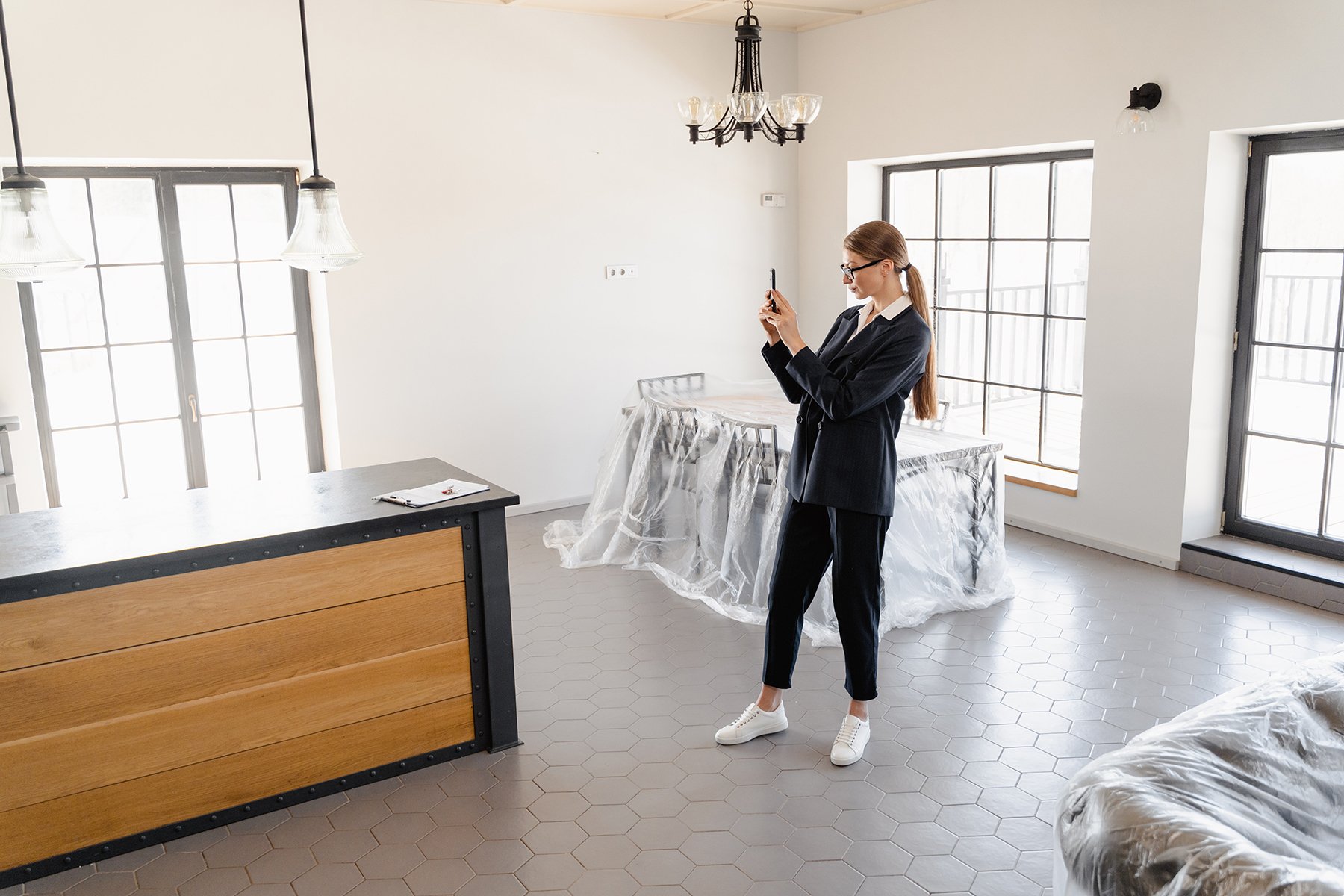
Flush the toilets, run all taps, check cabinet and door hinges, electrical sockets and signs of water damage along the walls. Every chip, dent and scratch should be meticulously documented. If your apartment comes fully furnished, this includes existing wear and tear, such as stains and cracks on furniture such as the couch or wardrobes.
Put the pictures in a comprehensive PDF file and email it to yourself and your agent to establish a date of proof. If you have videos, include them too.
Doing so ensures you’re protected if your landlord tries to find any reason to eat your deposit once your lease is up by kicking up a fuss over existing damages in the apartment.
Whip out that camera and get to work.
Any questions about renting in Singapore? Let us know in the comments section below or on our Facebook post.
If you found this article helpful, check out Rental viewing checklist for the savvy tenant and Here are 10 questions when renting in Singapore.
Looking for a property? Find the home of your dreams today on Singapore’s fastest-growing property portal 99.co! If you would like to estimate the potential value of your property, check out 99.co’s Property Value Tool for free. Also, don’t forget to join our Facebook community page or Telegram chat group! Meanwhile, if you have an interesting property-related story to share with us, drop us a message here — and we’ll review it and get back to you.
The post Rental tenancy agreement in Singapore – 5 things you must know appeared first on 99.co.

